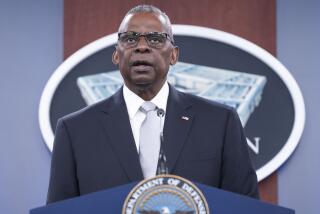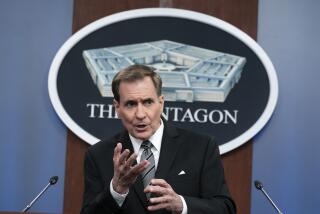Clinton Allows Stronger Military Response in Iraq
- Share via
WASHINGTON — President Clinton has authorized the U.S. military to strike back more aggressively when Iraq’s planes and air defenses threaten American pilots, his national security advisor said Tuesday.
Samuel R. “Sandy” Berger’s comments offered the strongest suggestion yet that the skirmishing over the Western-imposed “no-fly” zones over northern and southern Iraq could intensify further--and lead to greater carnage.
The comments came as U.S. officials acknowledged Tuesday that a U.S. missile had strayed off course Monday, plowing into a residential neighborhood near the southern city of Basra, as Iraqi officials had previously reported.
The errant missile killed 11 civilians and wounded dozens of others, according to Iraqi officials.
After four weeks of skirmishing over the no-fly zones--including new confrontations Tuesday--Berger said military commanders have been given “more expansive rules of engagement” against Iraqi provocations.
They are no longer only permitted to respond to Iraqi planes or ground installations that threaten them, he said, but can now also attack other parts of the broader air-defense network that is endangering fliers patrolling the zones.
“Our response, as appropriate, will be against any of the air-defense systems that we think make us vulnerable,” Berger told a group of defense writers.
U.S. planes have fired several dozen missiles at Iraqi targets since the latest round of confrontations began after last month’s U.S.-British air assault on Iraq.
Now, the risk to life may be rising: Iraqi President Saddam Hussein has been moving some of his air-defense equipment nearer to civilian population centers, U.S. officials say, in an echo of his “human shield” strategy at the time of the 1991 Persian Gulf War.
Officials insist that U.S. forces are going out of their way to avoid civilian casualties but must reply to threatening moves.
“We’re acting here in self-defense and in response to concerted attacks by Saddam Hussein,” Berger said.
The no-fly zones were set up after the Gulf War to keep Hussein from using aircraft to strike the Kurdish minority in the north and the Shiite Muslim population in the south.
As described by U.S. officials, the military’s new leeway apparently will not encompass the kind of intense assault unleashed last month after Iraq refused to allow U.N. weapons inspectors to do their jobs. Officials say that plans for broader attacks have been prepared and are “on the shelf” but that they have not been approved by civilian authorities.
Pentagon officials say U.S. forces have already inflicted substantial damage on an air-defense network that can’t be easily repaired because U.N.-mandated economic sanctions bar other countries from sending Hussein replacement parts.
However, U.S. pilots would face a considerable task if they wanted to take out all of Iraq’s air defenses.
Although Iraq’s system is out of date, it includes hundreds of Soviet-designed surface-to-air missile batteries, as well as big radars, communication installations and numerous antiaircraft artillery batteries.
On Monday, Pentagon officials said they were not certain that the U.S. missile had gone off course and struck a civilian neighborhood. On Tuesday, Pentagon spokesman Kenneth Bacon said the newly redesigned AGM-130 “did miss its target” by a few miles.
He said it was not yet clear what had gone wrong with the missile, a 12-foot-long weapon manufactured by Rockwell International at a cost of about $300,000 each.
Meanwhile, at the United Nations on Tuesday, arms inspectors outlined the steps they say need to be taken to try to ensure that Iraq does not rebuild its stockpiles of weapons of mass destruction.
While their report said a great deal had been accomplished in verifying arms and rendering harmless substantial portions of Iraq’s weapons capacity, the inspectors admitted: “During the first four years of its activities, the [monitoring team] had been very substantially misled by Iraq.”
Among other measures, the 250-page document called for creating regional monitoring and verification centers in Iraq to increase access to suspected weapons sites; additional computer experts to examine records; and substantial increases in staff and funding. The inspectors predicted that 400 experts would need to be recruited for short-term missions to Iraq.
Times staff writer John J. Goldman at the United Nations contributed to this report.
More to Read
Sign up for Essential California
The most important California stories and recommendations in your inbox every morning.
You may occasionally receive promotional content from the Los Angeles Times.











